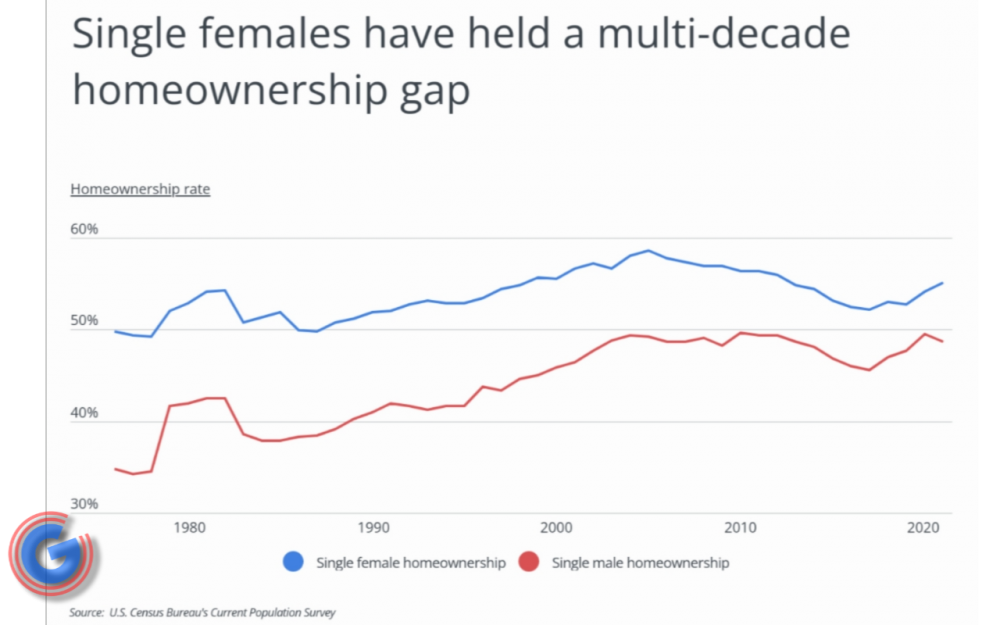Homeownership is a common goal for millions of Americans, but a number of social and economic factors can affect peoples’ ability to reach that milestone. From income to educational attainment to racial and ethnic background, there are significant gaps in homeownership rates between different demographic groups in the U.S. And family structure and gender are no different.
Married couples tend to have higher rates of homeownership and can afford more expensive homes due to combined financial resources. But for singles, the U.S. sees a gap between rates of homeownership by gender. In 2021, 55.1% of single females owned a home, compared to 48.6% of single males.
The percentage of single female homeowners has exceeded the share of single male homeowners, dating back at least 45-years. More than half of single women have been homeowners in all but five years since 1976, while the homeownership rate for single men has never topped 50% in that same time-frame. Despite this, the gap has narrowed over time. The homeownership rate for single women was more than 15 percentage points higher than the rate for single men in the late 1970s, but today the gap is just 6.5 percentage points.
In Tennessee, a recent analysis found the homeownership rate among single females is 56.85%, compared to 50.29% for single men. That number is almost 3-percentage points higher than the national average of 54.04%.
Here is a summary of the data for Tennessee:
- Female homeownership gap (percentage points): 6.56
- Single female homeownership rate: 56.85%
- Single male homeownership rate: 50.29%
- Median property value for single women: $140,000
- Median property value for single men: $140,000
For reference, here are the statistics for the entire United States:
- Female homeownership gap (percentage points): 5.66
- Single female homeownership rate: 54.04%
- Single male homeownership rate: 48.39%
- Median property value for single women: $175,000
- Median property value for single men: $175,000
MORE ON HOMEOWNERSHIP - Women attain these higher rates of homeownership despite being on the unfavorable end of a different gender gap in compensation. Women in the U.S. earn around $0.84 for every $1 earned by men in the U.S. Like the homeownership gap, the gender compensation gap has closed slightly over time, but many women still face a number of factors that limit their earnings. These include differences in jobs and industries worked across genders, loss of time and experience in the workforce due to motherhood or other caretaking responsibilities, and the effects of bias and discrimination on women’s wages and working conditions.
In light of this financial disadvantage, women are more likely than men to make sacrifices when saving for a home. A recent study from the National Association of Realtors found that single women buyers were more likely to report cutting back on spending for non-essential goods, entertainment, clothes, and travel, which emphasizes how important homeownership is to them. Additionally, women have been found to be more risk averse, and housing is widely considered to be a “safe” investment according to research produced by Fannie Mae.
Despite having lower wages, women homeowners are not necessarily making tradeoffs in the types of homes they purchase. According to the Census Bureau’s 2020 American Community Survey, the median self-reported home value for single female households and single male households is the same at $175,000. Married couple households, however, tend to own homes valued substantially higher than singles of either gender, with a median home value of $250,000.
The gap in homeownership varies across geographies in the U.S. In general, northern states in the Midwest and Northeast tend to have smaller gaps between the homeownership rate for men and women. And in one state, Minnesota, the homeownership rate for men actually exceeds the rate for women.
The homeownership gap is largest in the South and the Southwest, where the gender difference exceeds 7 percentage points in most locations. But the state that leads the U.S. in the size of the gender homeownership gap is Hawaii, where the homeownership rate for women is 8.7 percentage points higher than for men.
At the local level, cities in the South and Southwest also make up the bulk of the locations with the largest gender homeownership gap. California also places three cities in the top 15 largest gaps, including the nation-leading San Jose area, where the gap between male and female homeownership is nearly 11 percentage points.
The data used in this analysis is from the U.S. Census Bureau’s 2020 American Community Survey, the most recent data available. To determine the locations with the largest gender homeownership gaps, researchers at Porch calculated the percentage point difference between the single female homeownership rate and the single male homeownership rate. For the purposes of this study, single females and males were limited to those 18 years and older, not currently married (widowed, divorced, separated were considered single), and without children living in the same household. In the event of a tie, the state with the higher single female homeownership rate is ranked higher.
For more information, a detailed methodology, and complete results, you can find the original report on Porch’s website: https://porch.com/advice/cities-with-largest-gender-homeownership-gaps.





